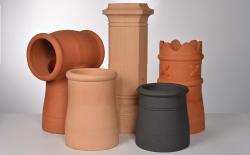Hepworth clay strengthens terracotta offering
 Terracotta is typically associated with the Victorian period; its decorative qualities suited the era’s ornamental style. However, terracotta offers much more than just aesthetic properties – and Hepworth Clay has been harnessing the material’s inherent strengths for the last five decades. Paul Wydell, Product Manager at Hepworth Clay, discusses terracotta’s timeless properties that have made it one of the business’ focal points for growth.
Terracotta is typically associated with the Victorian period; its decorative qualities suited the era’s ornamental style. However, terracotta offers much more than just aesthetic properties – and Hepworth Clay has been harnessing the material’s inherent strengths for the last five decades. Paul Wydell, Product Manager at Hepworth Clay, discusses terracotta’s timeless properties that have made it one of the business’ focal points for growth.
Q: With new homes and buildings with a modern architecture increasing in number, where does terracotta sit in the construction sector?
A: Terracotta is still used in a variety of applications, ranging from architectural tiles to roofing solutions. Its strength and functionality don’t allow it to become outdated. This particularly rings true for roofing solutions.
There are two reasons for this.
Firstly, although there has been a significant increase in new build homes, older styles or ‘period property’ are still desired by homeowners thanks to their authenticity and unique features. Therefore the demand for terracotta, the classic material mostly known for its association to traditional ceramic flue liners and chimney pots, is on the increase.
A recent survey by Selling Up/Populus provided an interesting insight into this continuing trend and some of the key reasons behind it. The research found that original period features, like fireplaces, were crucial deciding factors for individuals when buying a property, as it made them more desirable. Almost half of those surveyed (46 per cent) said that they would want an operational fireplace with original or period features in their dream home. With the majority agreeing that these features add character to a property, it’s clear that such elements can help boost the value of the house.
Second, there are a growing number of new homes and buildings that have been developed using traditional construction methods, such as slate or pan tiled roofs. Terracotta roofing works perfectly with such properties. One example of a roofing solution that can be used in this way is a terracotta ridge tile. These tiles are installed using cement mortar and supplementary fixings to ensure they remain in place in periods of high winds.
Q: What are some of the benefits of terracotta roofing?
A: As a natural material, terracotta is resistant to the effects of acid corrosion, extremes temperatures and weathering. Its natural qualities also mean it is sustainable and therefore a preferable choice for customers that want to reduce their home’s environmental impact. Terracotta is also resistant to the effects of atmospheric acid pollution, which means that it lasts longer than many other materials.
As such, terracotta roofing products help to maintain a watertight envelope for a building. They also serve to provide a decorative feature to enhance the aesthetics of the building.
From an aesthetic point of view, a terracotta fireplace can be a beautiful, traditional focus for the living space of a home. However, the fireplace, flue and chimney must be properly constructed to ensure that the potentially harmful products of combustion are safely vented to the outside of a building and do not pass into habitable spaces.
Q: How important is terracotta to the wider Hepworth Clay business?
A: Very. As mentioned earlier, the terracotta trend is on the rise, and as a leading manufacturer of terracotta-based building solutions, we are keen on catering to the demand.
Hepworth’s hallmark of precision manufacturing ensures clay is fired to perfection which guarantees a consistent quality, standards compliance and total service support. Therefore, we’ve recently invested £240,000 to upgrade one of our three industrial sized shuttle kilns used to fire our Hepworth Terracotta products.
Q: What does the upgrade mean for Hepworth Terracotta?
A: The upgrade involves a full refurbishment of the kiln, which will ensure that production is more efficient than ever before. The major overhaul of the kiln means that it will be able to yield a greater amount of fired terracotta, while increasing energy efficiency by 6 per cent.
The refurbished kiln will also provide increased insulation, ensuring increased thermal efficiency and a more controlled environment. This means that a greater variety of terracotta product combinations can be fired at the same time.
The refurbishment has also extended the life of the kiln by 20 years, enhancing the efficiency of the manufacturing process in the long run.
Q: What are Hepworth Terracotta’s long-term plans following this investment?
A: Clearly, terracotta is here to stay and therefore we will be exploring a range of avenues for further growth and investment in this space. Offering more than a century of terracotta manufacturing tradition, we are set to re-energise the marketplace with our wide range of sustainable, durable and proven products for the construction and ventilation of domestic flue and chimney systems, the finishing of rooflines and the ventilation of buildings via airbricks. The material has significant potential in the roofing solutions market and with our reputation and proven track record, we are confident that the opportunities for Hepworth Terracotta, in both residential and commercial sectors, will only increase.
For more information on Hepworth Terracotta and installation advice, visit www.hepworthterracotta.co.uk